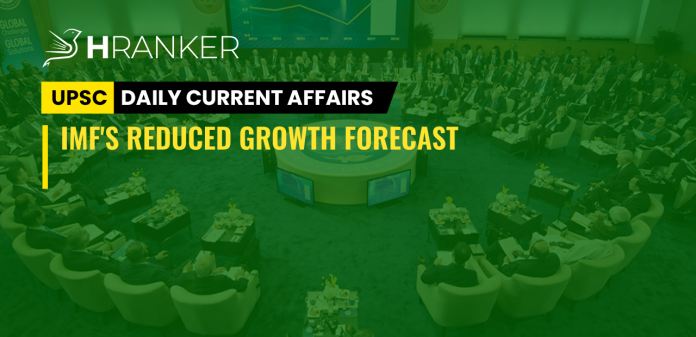WHAT’S IN NEWS: The International Monetary Fund’s (IMF) latest World Economic Outlook has rolled back growth prospects for the world and India. What are the reasons, and how does the outlook differ for advanced and other economies?
KEYWORDS:
- GDP: GDP stands for Gross Domestic Product. This includes the total market value of all the products, goods, and services produced within a country in a given time duration. It is used to measure the size of an economy and overall growth or decline in the nation’s economy.
- INFLATION: Inflation is the rate of increase in prices over a given period of time. Inflation is typically a broad measure, such as the overall increase in prices or the increase in the cost of living in a country. The buying power of consumers declines as overall prices increase.
WORLD ECONOMIC OUTLOOK (WEO) & ITS SIGNIFICANCE:
The IMF was established in 1944 in the wake of Great Depression of the 1930s. Today it has 190 countries as its members. As an organization, it provides loans – around $1 Trillion is available for lending to its member countries apart from providing expert guidance and surveillance to ensure economic and financial stability in the world economy.
IMF releases the World Economic Outlook report, twice a year. It gives details about the state of the global economy and its forecast for the near future.
WEO helps in assessment of the current state of the global economy as well as to help countries prepare for the threats and opportunities before them.
WEO & GLOBAL GROWTH:
The IMF projects a sharp fall in the global economic growth rate. Global growth is projected to slow from an estimated 6.1% in 2021 to 3.6% in 2022 and 2023. This is 0.8 and 0.2 percentage points lower for 2022 and 2023 than projected in January. Beyond 2023, global growth is forecast to decelerate even more, to about 3.3%.
Russia’s invasion of Ukraine is the key reason for this gloomy outlook.
According to IMF, this drag on output is expected to be more salient in emerging market and developing economies.
IMF had pointed to the dangerous divergence in economic prospects between advanced economies such as the USA and emerging economies such as India, it has started due to COVID and is reinforced by the Ukraine conflict and its wide-ranging ramifications.
The AVERAGE OUTPUT GAP (shown in the graph) is the difference between the actual and potential GDP. And on an average this gap is higher for emerging economies like India, especially for 2022-23.
The ‘Employment Losses’ as of 2024 (shown in the graph) when compared to pre-pandemic trend is showing widening gap for emerging and developing economies (EMDEs) like India.
It is important to note that this comparison here is with the pre-pandemic ‘trend’ and not the pre-pandemic ‘level’ of the Total GDP of a country.
WEO & INFLATION:
The disruptive impact of the Russia-Ukraine war caused prices of several commodities to skyrocket, creating a massive surge in Inflation across the world.
As per WEO, Inflation is expected to remain elevated for longer than in the previous forecast, driven by war-induced commodity price increases and broadening price pressures.
And the Emerging and Developing Economies (EMDEs) will be worse off in this case as well. For advanced economies, Inflation is projected at 5.7% whereas for EMDEs it is projected at 8.7%.
IMF has been less than hopeful for the future. It is because of worsening of the war, worsening of geopolitical tensions, a resurgence of the pandemic, increased social tensions, a worsening slowdown in China, higher inflation expectations, higher interest rates etc.
IMF’S GROWTH PROSPECTS ABOUT INDIA:
The IMF cut its forecast for India’s GDP growth in the current fiscal year to 8.2%, a 0.8 percentage point reduction from its previous projection which is one of the sharpest reductions in the world, as it downgraded the outlook for global growth citing the economic impact of the Russia-Ukraine war. It is partly because of lower net exports and weaker domestic demand, with higher oil prices which leads to decline in both consumption and investment.
The World Economic Outlook also projected India’s economy to expand by 6.9% next year, putting it on course to be the fastest growing large economy over the next two years, which is more than the average growth rate of both advanced and emerging economies.
INDIA ON THE GROWTH FRONT:
Each country has a different ‘required growth rate’. The pace at which a country grow depends largely on how well-off an average citizen of that country is. Each country needs to compete with its past self and aim for higher.
The prosperity of a country also depends upon population and share of the country in the global GDP. Countries that have a higher share in the Global GDP than their share in the global population, like all advanced economies are doing better than others.
Countries whose share of the Global population far outstrips their share in the global GDP such as India and Nigeria are the ones that face the highest required rate of GDP growth.
India has 18% of the world’s population and just 7% of global GDP. In the real world, this reflects low levels of Per Capita Income and consumption as well as high levels of unemployment and social unrest.
India not only has to grow at a much faster clip than the rest of the world but also has to do it sustainably for decades.




